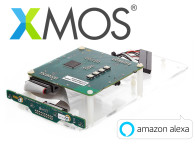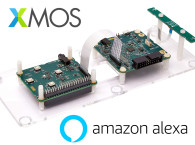
Built on XMOS’ xcore.ai chip infrastructure, the XVF3610 and XVF3615 designs mark an evolution of the XVF3510 voice processor already used within Amazon Alexa systems, and provide powerful acoustic echo cancellation (AEC) and interference cancellation algorithms to suppress noise from dominant sources and enable cross-room barge-in. The XVF3610 and XVF3615 also include automatic audio reference delay calibration – a critical capability for voice enabled TV systems – expanding the range of devices and environments where voice interfaces can be implemented.
The XMOS XVF3610 is now available in distribution. The XVF3615 adds embedded Amazon wakeword for single pass Alexa enabled systems, allowing manufacturers to offload wakeword processing from their host SoC systems, and will be available in distribution in January 2022. "In the face of a challenging supply chain, we can confirm that the XVF3610 and XVF3615 are available in volume on standard lead-times," the company confirms.
The new XMOS VocalFusion XVF3610 voice processor uses microphone array processing to capture clear, high-quality audio from anywhere in the room. These voice processors use highly optimized digital signal processing algorithms to implement barge-in, suppress point noise sources and reduce ambient noise levels, increasing the effective Signal to Noise Ratio (SNR) to achieve a reliable voice interface whatever the environment. Both processors implement specific features and interfaces required for use in closely integrated applications such and incorporated into a TV or set-top box. The XVF3610 supports two modes of operation using audio and control via a USB2.0 interface, or audio via I2S and control over I2C interfaces (3610-INT).

The improved Acoustic Echo Cancellation (AEC) algorithm enables the XVF3610 to detect voice signals in the presence of high volume, stereo audio from the product into which it is integrated. This process takes the stereo audio from the product as a reference signal and models the echo characteristics between each speaker and microphone caused by the acoustic environment of the device and room. These models are used to continuously remove the echoes from out the audio outputs from the microphone audio input, and continuously adapted to the acoustic environment to accommodate changes in the room created by events such as doors opening or closing and people moving in the room.
The XVF3610 also includes an Automatic Delay Estimator Control (ADEC) which is used to time-align the reference and microphone signals, allowing the AEC to work effectively. This is an essential aspect of device operation for situations where the audio output path is unknown, such as in TVs and set-top box architectures. The ADEC applies a time shift to one of the signals based on an automatic estimate between them or a user-defined delay, to deliver a synchronized input to the AEC.
The improved Interference Cancellation (IC) algorithm suppresses static noise from point sources such as cooker hoods, washing machines, or radios for which there is no reference audio signal available. When an internal Voice Activity Detector (VAD) indicates the absence of voice, the IC adapts to suppress point noise sources in the environment. When voice is detected adaption is suspended maintaining suppression of the interfering noise source.
In an additional development in the range of voice solutions offered by XMOS, the company launched an alpha phase for targeted customers for its new ‘Avona’ voice reference design. Leveraging the flexibility of the xcore.ai platform, Avona provides a customizable reference design for voice, wakeword, speech-to-intent and intelligent voice applications.
“Versatility is the key with all three of these new voice solutions, inherent in the structure of the xcore.ai chip. Designers are empowered to make choices: what balance of compute do we want? How much of the voice element is customizable? Are we coding on bare metal or in FreeRTOS? That dexterity will help them innovate in ways that they otherwise couldn’t,” states Rob Fisher, Product Director, XMOS.
Targeted at intelligent connected devices applications, the Avona voice reference design allows engineers to incorporate keyword, event detection or advanced local dictionary support to create a complete voice interface solution. Developers can also develop their own voice-based solutions using the xcore software development kit (SDK). Programmed In C or C++, and incorporating a FreeRTOS environment for user application code, the xcore SDK supports both bare-metal and RTOS use, offering total flexibility and the ability to add bespoke differentiation for the end product. The reference design will be made generally available in early 2022.

"The IoT market is creating new verticals and opportunities at breakneck speed, and we are seeing significant demand within the smart home. As more applications become commercially attractive or viable, engineers and designers need to be able to rely on hardware that offers agility and cost-effective performance without compromise on quality. Our new range of voice solutions deliver another weapon in their arsenal when it comes to voice control, enabling designers to continue to push the boundaries of voice innovation in the smart home and beyond,” says Mark Lippett, CEO, XMOS.
XMOS xcore processors allow product developers to architect system-on-chip solutions purely in software, enabling faster time to market with differentiated systems that are cost-effective and energy efficient. Including IO interfaces, FreeRTOS examples and support for TensorFlowLite for Microcontroller, the xcore SDK incorporates libraries and tools. XMOS also supplies development kits for all its voice products, including tools and resources to create devices that absorb contextual data from their environment, infer meaning from that data, and translate the results into action.
www.xmos.ai








